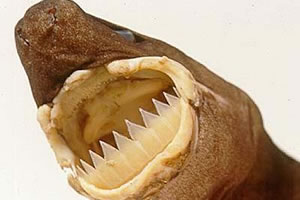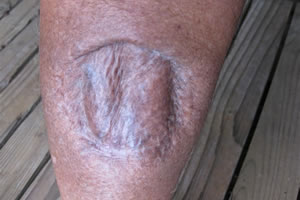The Cookie Cutter’s Nasty Bite

Michael Spalding’s cookie cutter shark attack was the first
documented on a living person. Photos courtesy Michael Spalding
Shark expert John Naughton once called it “the mosquito of the sea.” Only this mosquito can be more than a nuisance. Just ask Maui Realtor Michael Spalding.
The veteran ocean swimmer got a taste of the cookie cutter shark’s bite in March of 2009 while attempting to swim from Hawaii Island to Maui across the Alenuihaha channel. Spalding’s adventure was cut short when the nasty critter bit his chest and then took out a chunk of his leg.
“If you saw one of these 20-inch sharks swimming around you wouldn’t think anything of it, but they are nasty,” says the 61-yearold Spalding, who was about five hours into his swim when the shark made its move.
The attack happened at night when the cookie cutter shark makes its way to the ocean’s surface to feed. The shark has been found in deep water at about 3,000 feet. Spalding’s bite left a cookie-shaped wound that was about 1-inch deep and about 3 inches in diameter.
The attack was recently confirmed by Florida and Hawaii researchers as the first documented attack on a living person. Their study will be published in an upcoming edition of the journal Pacific Science.

Cookie cutter shark bite
News of the confirmed attack was met with mixed reviews with ocean users.
“Never knew we had them in Hawaiian waters,” says surfer Pat Almeida. “Won’t change what I do out here.”
“I don’t know about you, but I won’t be surfing past sunset,” laughs Wes Pablo. “I don’t care how small they are, a shark is still a shark.”
Don’t let its friendly name fool you. Cookie cutter sharks have razor-like teeth, and although they only grow to 22 inches long, they have powerful jaws and they are efficient. Their bite resembles a surgeon’s cut.
Again, just ask Michael Spalding. “I knew I had to get out of the water because something bad was down there,” he says.
“They’re kind of hit-andrun predators,” says Waikiki Aquarium director Andrew Rossiter. “They swim into the object with their mouth open, clamp on, twist, close their jaws and pull out a very neat plug of flesh about the size of a golf ball.”
Cookie cutter sharks normally prey on fish like ahi, marlin and even other sharks. They’ve also been known to bite monk seals, whales and dolphins. There are reports of cookie cutter sharks leaving marks on the sonar domes of nuclear submarines.
“If you go down to the fish market in Honolulu and check out the fish there, you’ll find that many of them have golf ball-sized holes in the side,” says Rossiter. “It used to be thought that was from a parasite or something similar, but we now know it’s from cookie cutter sharks attacking these fish while they’re on the line.”

Cookie cutter sharks clamp on, twist, close their jaws and pull out a plug of flesh. Photo from Ron Mizutani
Humans aren’t usually on their diet unless you’re swimming in their environment at night. Scientists say swimmers should take caution when out in deep waters at night, especially during bright moonlight. The sharks are attracted to light.
“Very, very unusual the guy was incredibly unlucky he’s the only one in the world,” says Rossiter. “If the cookie cutter had caught a vein or an artery, he would have probably bled to death because they’re very, very efficient at pulling out plugs.”
“I’m not swimming at night, even if they aren’t fast movers,” laughs Pablo. “No cookies coming out this body!”
While cookie cutter sharks are fairly widespread and can be found in the Atlantic, Indian and Pacific oceans, Rossiter says there’s no reason to be overly concerned.
“Unless you’re way, way offshore, it is very, very unlikely that you’ll encounter them,” he says. “But they’re out there for sure, so be careful.”
Just ask Michael Spalding.



